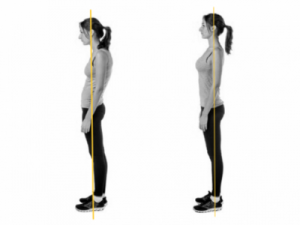Your correct posture and core stability explained!
A lot of people get confused on what their core is and how to perform your correct posture for exercise, so in this blog I am going to take a moment to talk about your posture and core stability.
Your core is the whole of your mid-section – or the trunk of your body. It is made up of your abdominals (abs), your oblique’s (internal & external) and your lower back. You also have a deeper layer of muscle that wraps around your trunk called the transverse abs or TVA.
Now, how do we train all these muscles? First of all we need to take a look at our posture or our neutral alignment. This will increase the effectiveness of any exercise by activating the pelvic stabilising muscles used to form a supportive girdle around your lower back.
Neutral alignment is when all major joints are in line with one another: Your body and legs would be neutrally aligned when you can draw a straight line from your shoulder to your ankles passing through your hips and knees.
To make sure you have the correct posture you need to;
 Stand with feet hip width apart facing forward
Stand with feet hip width apart facing forward- Feet firmly on the ground with your weight evenly distributed
- Knees relaxed and in align with feet
- Shoulders back, chest out
- Make sure your shoulders are relaxed!
- Place your finger on your belly button and pull your tummy in, then release by about 30%, this will neutralise your pelvis. (Do not push back or forward)
- Head straight, chin up and roughly parallel to the ground
- Use a mirror to see if your earlobes, shoulders, hips, knees and ankles are aligned
You should be able to put a broom or stick up to your back and the back of your head, shoulders, and buttocks should all be touching it. This will be called your neutral position or neutral spine.
We can train our core with specific exercises that target these muscles. Yes we can do static exercises like the plank, and more dynamic exercises like side leans but there are some great ways of training your core and improving your balance, especially when it comes to using equipment like stability balls and bosu trainers. These are great pieces of kit as you can train other specific muscles as well as training your core.
Stability is required to hold a correct posture and a lack of balance and stability around your core and joints can lead to injury, and back and neck pain. Effective muscle proprioception is vital when maintaining balance and stability. The nature and instability of using a stability ball or bosu when a body rests against it makes it the perfect training tool. It helps improve your centre or balance and strengthen your core..
What results can you expect from using a stability ball or bosu trainer?
- As well as getting the same benefits you would from strength training such as;
- Grater muscle strength, power and endurance
- Improved metabolism, body weight control and energy levels
- Prevention of muscle and joint atrophy (loss of muscle mass)
- Reduced risk of injury
You will also benefit from;
- Enhanced balance, stability and control of deep muscles
- Improve posture
- Improve support around your joints
- Greater range of movement in joints
- (Increased strength in your core)
We all know what a stability ball looks like. Its basically a large inflatable ball and is used in a wide variety of fitness. The nature and instability of a ball when a body resists against it, helps to improve your centre of balance and strengthen your core. It also helps improve your muscle control and coordination. There are many names for the stability ball, such as gym ball, swiss ball, aerobic ball etc. They can also come in many different sizes, usually depending on your height.
| Height | Ball size required |
| under 5′ | 45 cm (18 in) |
| 5’1″ – 5′ 7″ | 55 cm (22 in) |
| 5′ 8″ – 6′
6’1″ – 6’3″ |
65 cm (26 in)
75 cm (30 in) |
To check that you have the right size stability ball, sit on the top and centre of it with your feet firmly on the floor. Your hips should be level or slightly higher than your knees with them ideally at a 90 degree angle.
A BOSU (‘BOth Sides Up’) is a fitness training device usually used for balance and core training. It consists of an inflated rubber hemisphere attached to a rigid platform. It basically looks like a stability ball cut in half. Dome side up makes an unstable surface while device remains stable and dome side down makes it highly unstable. There are also other bosu trainers that are smaller in size called the aerostep and airdisc. The maximum dome height for an actual bosu trainer is approximately 20-25 cm (8-10 in).
Examine the stability ball or bosu before each time you use it, checking for stress marks and punctures, make sure you purchase an anti-burst stability ball as these are designed to take upto 300kg load.
To check that the stability ball or bosu is correctly inflated, you will just need to perform a simple task of using your thumb by pressing down onto the stability ball. If you can push your thumb into the inflated ball further than an inch then it needs inflating.
Stability balls and bosu trainers should ideally be kept at room temperature otherwise it can have a negative effect on its expansion properties.
Why not check out one or all of these short stability ball workouts. They last between 15 and minutes each.
.






